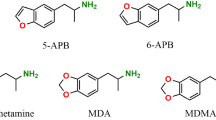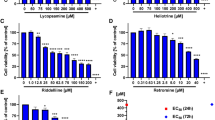Abstract
N-Benzylpiperazine (BZP) and 1-(3-trifluoromethylphenyl)piperazine (TFMPP) are two synthetic phenylpiperazine analogues that have been frequently commercialized in combination as an alternative to ecstasy (‘Legal X’). Despite reports of several clinical complications following the use of these drugs in association, few studies have been conducted so far to elucidate their combined toxicity. The present study was aimed at clarifying the cytotoxic effects of mixtures of BZP and TFMPP in vitro. Human-derived HepaRG cells and primary rat hepatocytes were exposed to the drugs, individually or combined at different mixture ratios, and cytotoxicity was assessed by the MTT assay. Mixture additivity expectations were calculated by the independent action and the concentration addition (CA) models and compared with the experimental outcomes. To delineate the mechanisms underlying the elicited effects, a range of stress endpoints was evaluated, including oxidative stress, energetic imbalance, and metabolic interactions. It was observed that primary rat hepatocytes are more sensitive than HepaRG cells to the toxicity of BZP (EC50 2.20 and 6.60 mM, respectively) and TFMPP (EC50 0.14 and 0.45 mM, respectively). For all BZP–TFMPP combinations tested, CA was the most appropriate model to predict the mixture effects. TFMPP proved to act additively with BZP to produce significant hepatotoxicity (p < 0.01). Remarkably, substantial mixture effects were observed even when each drug was present at concentrations that were harmless individually. In primary hepatocytes, a small deviation from additivity (antagonism) was observed toward the upper range of the concentration–response curve. GC/MS data suggest that a metabolic interaction may be at a play, as the mixture favors the metabolism of both substances, to a significant extent in the case of BZP (p < 0.05). Also, our results demonstrate the influence of oxidative stress and energetic imbalance on these effects (increase in RNS and ROS production, decrease in intracellular GSH/GSSG, ATP depletion and mitochondrial Δψm disruption). The present work clearly demonstrates that potentially harmful interactions among BZP and TFMPP are expected when these drugs are taken concomitantly.












Similar content being viewed by others
References
Antia U, Lee HS, Kydd RR, Tingle MD, Russell BR (2009a) Pharmacokinetics of ‘party pill’ drug N-benzylpiperazine (BZP) in healthy human participants. Forensic Sci Int 186(1–3):63–67. doi:10.1016/j.forsciint.2009.01.015
Antia U, Tingle MD, Russell BR (2009b) In vivo interactions between BZP and TFMPP (party pill drugs). N Z Med J 122(1303):29–38
Antia U, Tingle MD, Russell BR (2009c) Metabolic interactions with piperazine-based ‘party pill’ drugs. J Pharm Pharmacol 61(7):877–882. doi:10.1211/jpp/61.07.0006
Antia U, Tingle MD, Russell BR (2010) Validation of an LC-MS method for the detection and quantification of BZP and TFMPP and their hydroxylated metabolites in human plasma and its application to the pharmacokinetic study of TFMPP in humans. J Forensic Sci 55(5):1311–1318. doi:10.1111/j.1556-4029.2010.01457.x
Araujo AM, Valente MJ, Carvalho M et al (2015) Raising awareness of new psychoactive substances: chemical analysis and in vitro toxicity screening of ‘legal high’ packages containing synthetic cathinones. Arch Toxicol 89(5):757–771. doi:10.1007/s00204-014-1278-7
Arbo MD, Bastos ML, Carmo HF (2012) Piperazine compounds as drugs of abuse. Drug Alcohol Depend 122(3):174–185. doi:10.1016/j.drugalcdep.2011.10.007
Arbo MD, Silva R, Barbosa DJ et al (2014) Piperazine designer drugs induce toxicity in cardiomyoblast h9c2 cells through mitochondrial impairment. Toxicol Lett 229(1):178–189. doi:10.1016/j.toxlet.2014.06.031
Arbo MD, Silva R, Barbosa DJ et al (2016) In vitro neurotoxicity evaluation of piperazine designer drugs in differentiated human neuroblastoma SH-SY5Y cells. J Appl Toxicol JAT 36(1):121–130. doi:10.1002/jat.3153
Austin H, Monasterio E (2004) Acute psychosis following ingestion of ‘Rapture’. Australas Psychiatry 12(4):406–408. doi:10.1111/j.1440-1665.2004.02137.x
Baumann MH, Clark RD, Budzynski AG, Partilla JS, Blough BE, Rothman RB (2005) N-substituted piperazines abused by humans mimic the molecular mechanism of 3,4-methylenedioxymethamphetamine (MDMA, or ‘Ecstasy’). Neuropsychopharmacology 30(3):550–560. doi:10.1038/sj.npp.1300585
Berenbaum MC (1989) What is synergy? Pharmacol Rev 41(2):93–141
Bliss CI (1939) The toxicity of poisons applied jointly. Ann Appl Biol 26:585–615
Carvalho M, Pontes H, Remiao F, Bastos ML, Carvalho F (2010) Mechanisms underlying the hepatotoxic effects of ecstasy. Curr Pharm Biotechnol 11(5):476–495
Chou K (2008) Distribution of BZP and TFMPP. Masters thesis, University of Auckland
Cole M (2011) Poison in party pills is too much to swallow. Nature 474(7351):253. doi:10.1038/474253a
Davies S, Wood DM, Smith G et al (2010) Purchasing ‘legal highs’ on the Internet—is there consistency in what you get? QJM 103(7):489–493. doi:10.1093/qjmed/hcq056
Dias da Silva D, Carmo H, Lynch A, Silva E (2013a) An insight into the hepatocellular death induced by amphetamines, individually and in combination: the involvement of necrosis and apoptosis. Arch Toxicol 87(12):2165–2185. doi:10.1007/s00204-013-1082-9
Dias da Silva D, Carmo H, Silva E (2013b) The risky cocktail: what combination effects can we expect between ecstasy and other amphetamines? Arch Toxicol 87(1):111–122. doi:10.1007/s00204-012-0929-9
Dias da Silva D, Silva E, Carmo H (2013c) Cytotoxic effects of amphetamine mixtures in primary hepatocytes are severely aggravated under hyperthermic conditions. Toxicol In Vitro 27(6):1670–1678. doi:10.1016/j.tiv.2013.04.010
Dias da Silva D, Silva E, Carmo H (2014a) Combination effects of amphetamines under hyperthermia—the role played by oxidative stress. J Appl Toxicol JAT 34(6):637–650. doi:10.1002/jat.2889
Dias da Silva D, Silva E, Carvalho F, Carmo H (2014b) Mixtures of 3,4-methylenedioxymethamphetamine (ecstasy) and its major human metabolites act additively to induce significant toxicity to liver cells when combined at low, non-cytotoxic concentrations. J Appl Toxicol JAT 34(6):618–627. doi:10.1002/jat.2885
Dias-da-Silva D, Arbo MD, Valente MJ, Bastos ML, Carmo H (2015) Hepatotoxicity of piperazine designer drugs: comparison of different in vitro models. Toxicol In Vitro 29(5):987–996. doi:10.1016/j.tiv.2015.04.001
Drug Enforcement Administration (2009) Various tablets containing BZP and TFMPP in Washington, D.C. Microgram Bull 42(7):64
Drugs-forums (2005) BZP/TFMPP piperazine mix. https://drugs-forum.com/forum/showthread.php?t=6012
Elliott S (2011) Current awareness of piperazines: pharmacology and toxicology. Drug Test Anal 3(7–8):430–438. doi:10.1002/dta.307
Elliott S, Smith C (2008) Investigation of the first deaths in the United Kingdom involving the detection and quantitation of the piperazines BZP and 3-TFMPP. J Anal Toxicol 32(2):172–177
Erowid (2003) Erowid piperazine vault: trifluoromethylphenylpiperazine (TFMPP)—an entheogenic entactogen. http://www.erowid.org/chemicals/tfmpp/tfmpp_article1.shtml. Accessed 29 Jan 2016
Erowid (2004) Erowid experience vaults: piperazine reports. http://www.erowid.org/chemicals/piperazines. Accessed 28 Mar 2016
European Monitoring Centre for Drugs and Drug Addiction (EMCDDA) (2015) New psychoactive substances in Europe. An update from the EU Early Warning System (March 2015). Publications Office of the European Union, Luxembourg. http://www.emcdda.europa.eu/publications/2015/newpsychoactive-substances
Fantegrossi WE, Winger G, Woods JH, Woolverton WL, Coop A (2005) Reinforcing and discriminative stimulus effects of 1-benzylpiperazine and trifluoromethylphenylpiperazine in rhesus monkeys. Drug Alcohol Depend 77(2):161–168. doi:10.1016/j.drugalcdep.2004.07.014
Faust M, Altenburger R, Backhaus T et al (2003) Joint algal toxicity of 16 dissimilarly acting chemicals is predictable by the concept of independent action. Aquat Toxicol 63(1):43–63
Gee P, Fountain J (2007) Party on? BZP party pills in New Zealand. N Z Med J 120(1249):U2422
Gee P, Gilbert M, Richardson S, Moore G, Paterson S, Graham P (2008) Toxicity from the recreational use of 1-benzylpiperazine. Clin Toxicol 46(9):802–807. doi:10.1080/15563650802307602
Gerets HH, Tilmant K, Gerin B et al (2012) Characterization of primary human hepatocytes, HepG2 cells, and HepaRG cells at the mRNA level and CYP activity in response to inducers and their predictivity for the detection of human hepatotoxins. Cell Biol Toxicol 28(2):69–87. doi:10.1007/s10565-011-9208-4
Kortenkamp A (2007) Ten years of mixing cocktails: a review of combination effects of endocrine-disrupting chemicals. Environ Health Perspect 115(Suppl 1):98–105. doi:10.1289/ehp.9357
Kretzschmar M, Pfeifer U, Machnik G, Klinger W (1992) Glutathione homeostasis and turnover in the totally hepatectomized rat: evidence for a high glutathione export capacity of extrahepatic tissues. Exp Toxicol Pathol 44(5):273–281. doi:10.1016/S0940-2993(11)80244-7
Lin JC, Bangs N, Lee H, Kydd RR, Russell BR (2009) Determining the subjective and physiological effects of BZP on human females. Psychopharmacology 207(3):439–446. doi:10.1007/s00213-009-1669-2
Lin JC, Jan RK, Kydd RR, Russell BR (2011) Subjective effects in humans following administration of party pill drugs BZP and TFMPP alone and in combination. Drug Test Anal 3(9):582–585. doi:10.1002/dta.285
Loewe S, Muchnik H (1926) Effect of combinations: mathematical basis of the problem. Arch Exp Pathol Pharmakol 114:313–326
Luft B, Dessauer P (2013) Emerging psychoactive substances—spotlight on ‘legal-highs’. In: Graylands hospital drug bulletin, vol 20. North Metropolitan Health Service—Mental Health
Persona K, Polus A, Goralska J, Gruca A, Dembinska-Kiec A, Piekoszewski W (2016) an in vitro study of the neurotoxic effects of N-benzylpiperazine: a designer drug of abuse. Neurotox Res. doi:10.1007/s12640-016-9604-x
Staack RF, Maurer HH (2005) Metabolism of designer drugs of abuse. Curr Drug Metab 6(3):259–274
Staack RF, Fritschi G, Maurer HH (2002) Studies on the metabolism and toxicological detection of the new designer drug N-benzylpiperazine in urine using gas chromatography-mass spectrometry. J Chromatogr B Anal Technol Biomed Life Sci 773(1):35–46
Staack RF, Fritschi G, Maurer HH (2003) New designer drug 1-(3-trifluoromethylphenyl) piperazine (TFMPP): gas chromatography/mass spectrometry and liquid chromatography/mass spectrometry studies on its phase I and II metabolism and on its toxicological detection in rat urine. J Mass Spectrom JMS 38(9):971–981. doi:10.1002/jms.513
Staack RF, Paul LD, Springer D, Kraemer T, Maurer HH (2004) Cytochrome P450 dependent metabolism of the new designer drug 1-(3-trifluoromethylphenyl)piperazine (TFMPP). In vivo studies in Wistar and Dark Agouti rats as well as in vitro studies in human liver microsomes. Biochem Pharmacol 67(2):235–244
Thompson I, Williams G, Aldington S et al (2008) The benzylpiperazine (BZP)/trifluoromethylphenylpiperazine (TFMPP) and alcohol safety study. Report for the Ministry of Health. Medical Research Institute of New Zealand, Wellington
Tu M, Sun S, Wang K et al (2013) Organic cation transporter 1 mediates the uptake of monocrotaline and plays an important role in its hepatotoxicity. Toxicology 311(3):225–230. doi:10.1016/j.tox.2013.06.009
Valente MJ, Araujo AM, Silva R et al (2015) 3,4-Methylenedioxypyrovalerone (MDPV): in vitro mechanisms of hepatotoxicity under normothermic and hyperthermic conditions. Arch Toxicol. doi:10.1007/s00204-015-1653-z
Vaughan BR, Gautam L (2011) An investigation into the cellular cytotoxicity of benzylpiperazine (BZP) and its derivatives. In: American Academy of Forensic Sciences (AAFS) 63rd Annual Meeting, Chicago, IL, 2011, vol 17
Wood DM, Button J, Lidder S, Ramsey J, Holt DW, Dargan PI (2008) Dissociative and sympathomimetic toxicity associated with recreational use of 1-(3-trifluoromethylphenyl) piperazine (TFMPP) and 1-benzylpiperzine (BZP). J Med Toxicol 4(4):254–257
Young SA, Thrimawithana TR, Antia U et al (2013) Pharmaceutical quality of “party pills” raises additional safety concerns in the use of illicit recreational drugs. N Z Med J 126(1376):61–70
Acknowledgments
This work received financial support from the European Union (FEDER funds) under the framework of QREN (projects SAESCTN-PIIC&DT/1/2011-Norte-07-0124-FEDER-000066 and SAESCTN-PIIC&DT/1/2011-Norte-07-0124-FEDER-000067) and through the Program PT2020 (project 007265-UID/QUI/50006/2013 and NORTE-01-0145-FEDER-000024). The work was also supported by national funds (Fundação para a Ciência e Tecnologia, FCT) through the projects Pest-C/EQB/LA0006/2013 and UID/MULTI/01378/2013. To all financing sources the authors are greatly indebted.
Author information
Authors and Affiliations
Corresponding authors
Ethics declarations
Conflict of interest
The authors declare that they have no conflict of interest.
Ethical approval
All applicable international, national and institutional guidelines for the care and use of animals were followed. All procedures performed in studies involving animals were in accordance with the ethical standards of the institution at which the studies were conducted.
Rights and permissions
About this article
Cite this article
Dias da Silva, D., Silva, M.J., Moreira, P. et al. In vitro hepatotoxicity of ‘Legal X’: the combination of 1-benzylpiperazine (BZP) and 1-(m-trifluoromethylphenyl)piperazine (TFMPP) triggers oxidative stress, mitochondrial impairment and apoptosis. Arch Toxicol 91, 1413–1430 (2017). https://doi.org/10.1007/s00204-016-1777-9
Received:
Accepted:
Published:
Issue Date:
DOI: https://doi.org/10.1007/s00204-016-1777-9




